  An eclipse is a celestial event that changes the appearance of the two biggest objects we see in our sky: the sun and moon. Eclipses happen when Earth, the moon, and the sun line up. NOTE: it is impossible to show a diagram to scale on the width of a computer screen and still be able to make out what's happening. The distances involved are big! For example, if we were to show the earth as a circle 1 centimetre in diameter, the moon at that scale would be a pinhead 30 centimetres away, and the sun would be a basketball over 100 metres away! Except for a specific and brief period of time during a total solar eclipse, you must never look directly at the sun without proper eye protection, such as safe solar viewing glasses (eclipse glasses). Eclipse glasses are NOT the same as regular sunglasses; regular sunglasses are not safe for viewing the sun. Optical devices such as cameras, telescopes, or binoculars can greatly magnify sunlight's intensity, making them also unsafe for viewing an eclipse. During a solar eclipse, you must wear your eclipse glasses (or use other solar filters) to view the Sun directly during the partial eclipse phase. You can only take your glasses off during the short time when the moon completely obscures the sun – known as the period of totality. If you don't have eclipse glasses, you can use welding glasses with a shade level of 14. you can also use an indirect viewing method, such as a pinhole projector, which projects an image of the Sun onto a nearby surface. A solar eclipse occurs when the moon passes between the sun and the earth. Because the moon's orbit around the earth is not in the same plane as the earth's orbit around the sun, eclipses don't happen often, and sometimes are only partial, depending on where you are on earth. 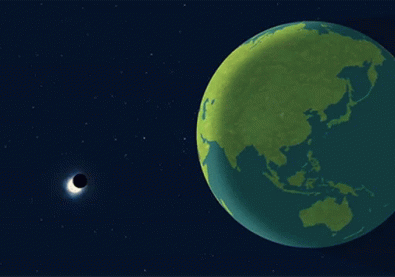 A solar eclipse happens as the moon obscures the sun. The distance of the moon from earth is coincidentally just about perfect for this to happen.
A solar eclipse happens as the moon obscures the sun. The distance of the moon from earth is coincidentally just about perfect for this to happen. The most exciting type is a total eclipse, where the moon completely covers the face of the sun, leaving just a thin ring of light, the Sun's corona or outer atmosphere, which is otherwise usually obscured by the bright face of the Sun. On the surface of earth, if you are in the path of complete shadow (the umbra) it will become as dark as night for a few minutes. 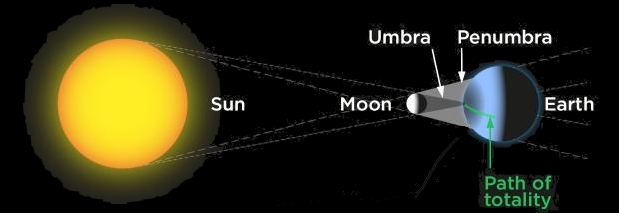 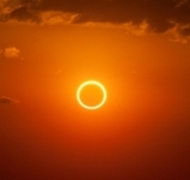
Because the moon's orbit is slightly elliptical, there are times when the moon is closer to earth by as much as 40,000 km (a tenth of its distance from earth). During a solar eclipse, this will result in the moon's face being noticeable smaller than the face of the sun, creating a thicker ring of light than during a regular total eclipse. This is called an annular eclipse. 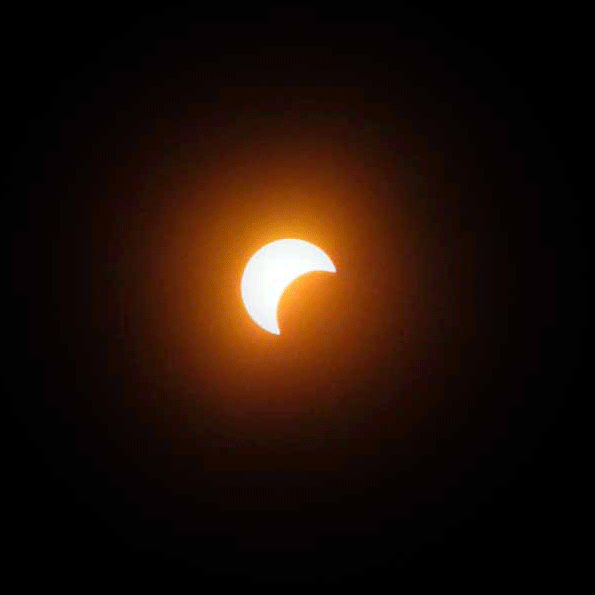
Partial Solar Eclipse If you are located at a spot on earth where the complete shadow doesn't pass directly overhead, the eclipse won't be total. But if you are still in partial shadow (the penumbra) the moon will cut off light from just a portion of the sun's face, creating a partial eclipse. A lunar eclipse happens when the earth passes between the sun and the moon. 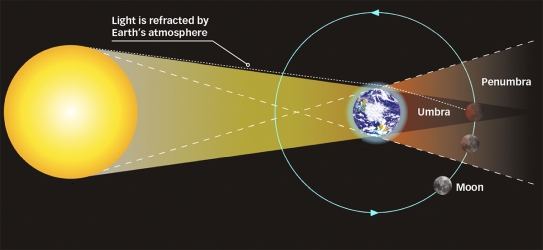 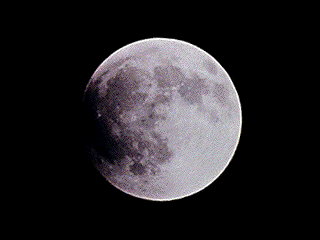 Because sunlight is refracted by the earth's atmosphere, some light is bent enough to light up the surface of the moon, so even a total lunar eclipse does not result in a totally dark moon, but rather a moon with a faint reddish colour. Predicting Eclipses Solar eclipses occur in patterns. The Saros Series is a period of 223 lunar months that has been used to predict eclipses for thousands of years. In a Saros Series, exactly 9 years, 5.5 days after any lunar eclipse, a solar eclipse will occur, and vice versa. Approximately 6585.3211 days, or 18 years, 11 days, and 8 hours after one eclipse, the Sun, Earth, and Moon return to about the same relative geometry, and a nearly identical eclipse occurs. These similar eclipses are part of the same Saros Cycle, and the time between the two eclipses is called a saros. From domestic chickens to horses, the sky darkening definitely sees a reaction from most farm animals. However, many of them are actually responding to the change in temperature rather than the change in light. If an eclipse occurs on a warm day, once the sun gets blocked by the moon, the temperature cools rapidly. Most farm animals begin performing their evening or nighttime rituals, like grooming, sleeping, or eating. A solar eclipse will also affect insects and birds. In the moments before an eclipse becomes total, there’s more buzzing, chirping, and singing than at any other hour of the day. But once the eclipse hits totality, everything falls silent. Some birds also change their song patterns, while others may fly in odd formations. Many wild animals also respond to solar eclipses because they are crepuscular ... most active in the twilight at dawn or dusk. Deer, bison, porcupines, rabbits, and coyotes are all going to react to a darkening sky. Their instincts are telling them that it’s time to begin their routine for the evening — searching for food, grooming, and preparing to sleep. |